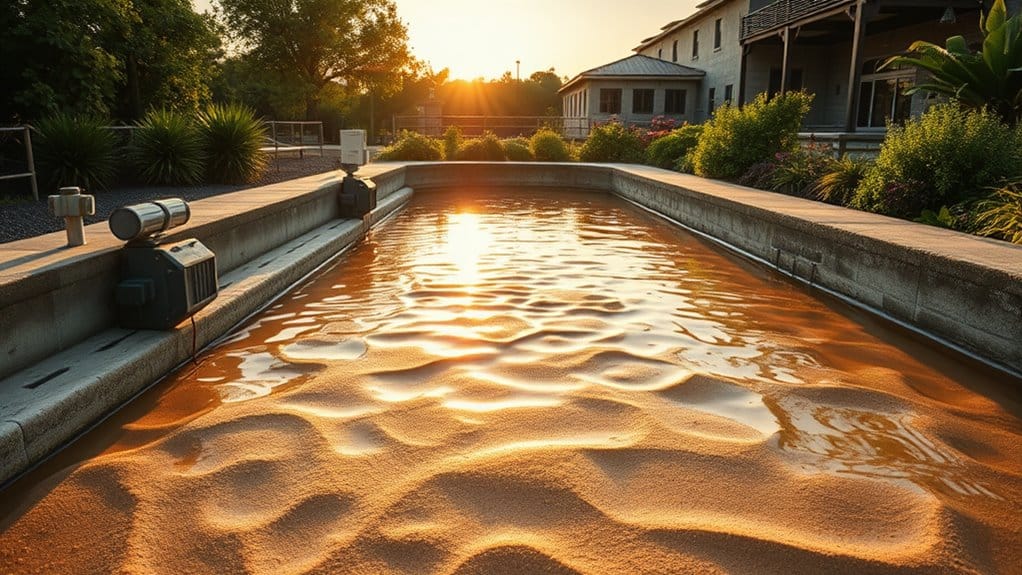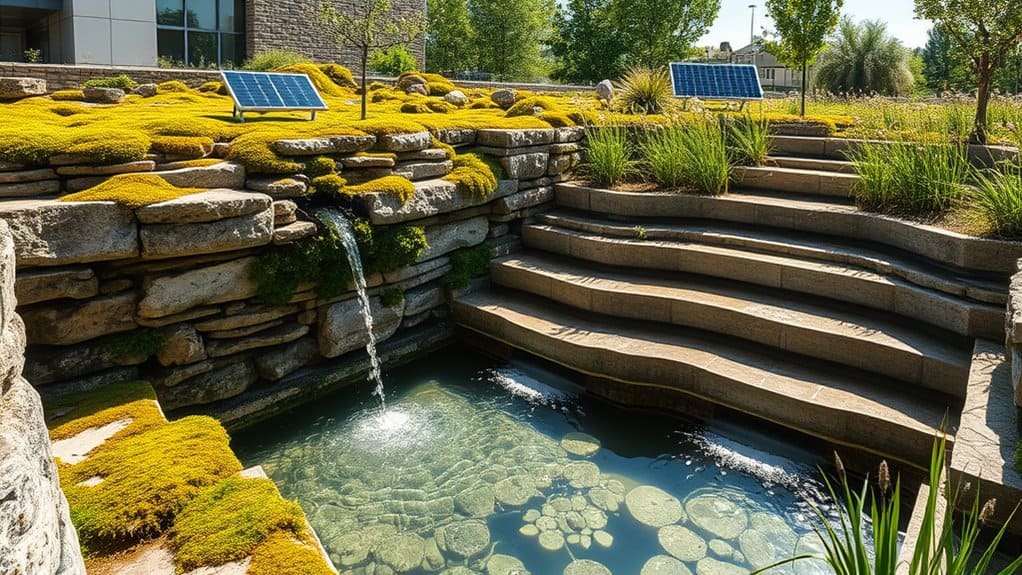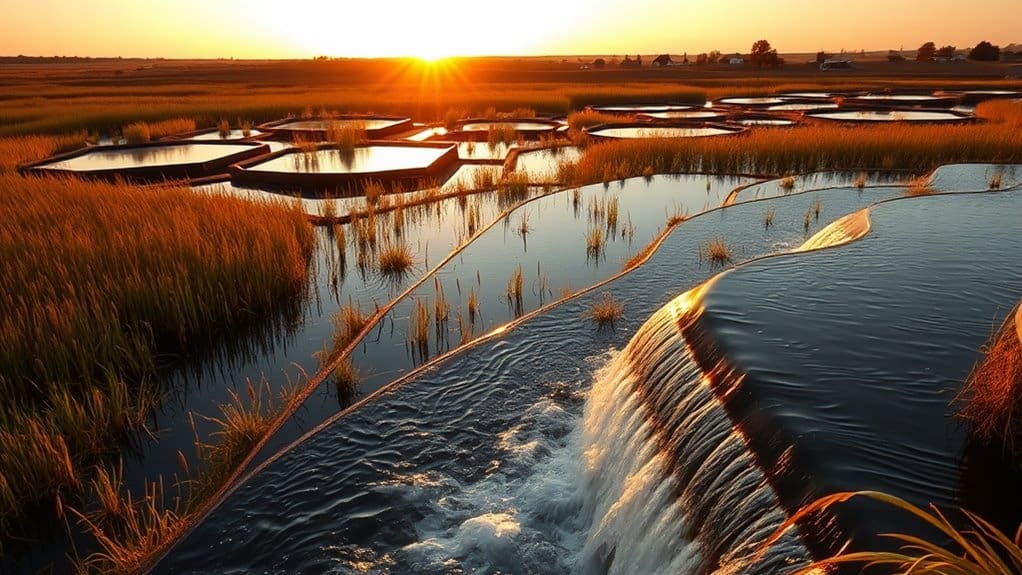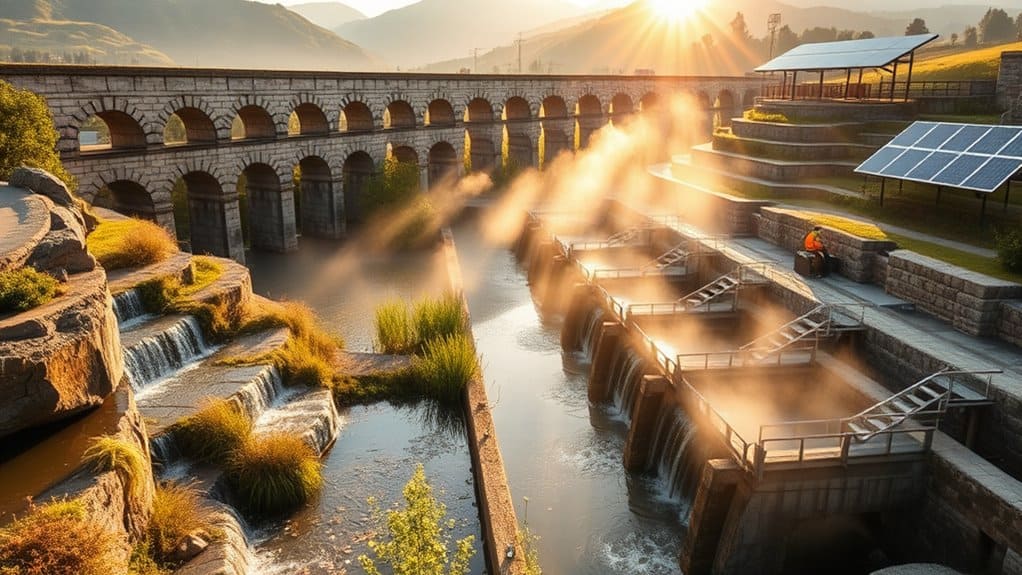Slow sand filtration is making a remarkable comeback in water treatment systems worldwide. We’re witnessing municipalities and green builders rediscover this 19th-century technology for its biological purification power through the “schmutzdecke” layer. It removes 99.9% of pathogens without chemicals while consuming 15-40% less energy than conventional methods. At $0.30-0.85 per cubic meter, it’s both economically and environmentally superior. The following sections reveal how this gravity-driven system is revolutionizing sustainable water management.
How Slow Sand Filtration Works: Nature’s Water Purification System

While modern water treatment facilities rely heavily on chemical additives and energy-intensive processes, slow sand filtration harnesses natural biological mechanisms to produce potable water.
The system employs a schmutzdecke—a biologically active layer that forms atop fine sand beds. This gelatinous biofilm contains microorganisms that trap, digest, and neutralize pathogens as water percolates downward.
We’ve documented removal rates of 99.9% for bacteria and protozoa without chemical intervention. The slow hydraulic loading rate (0.1-0.3 m/h) optimizes contact time between contaminants and the biological treatment matrix.
This gravity-driven system requires minimal maintenance beyond periodic schmutzdecke removal, functioning effectively for decades with proper design parameters.
The Rise, Fall, and Rebirth of a Time-Tested Technology

Despite its proven efficacy, slow sand filtration‘s prominence in municipal water treatment has followed a distinct historical arc that mirrors our technological evolution.
We witnessed its rise in the late 1800s when cities implemented these systems to combat waterborne diseases. By the 1920s, rapid sand filtration displaced it with chemical disinfection and mechanical processes that required less space.
Today, we’re rediscovering this technology’s value. Its minimal energy requirements, reduced chemical usage, and operational simplicity make it attractive for sustainable water management. Modern adaptations have addressed historical limitations while preserving the core biological mechanisms that make slow sand filtration exceptionally effective for pathogen removal.
Modern Applications: From Rural Villages to Green Buildings

Because of its operational simplicity and minimal resource requirements, slow sand filtration has found renewed applications across diverse settings worldwide. We’re witnessing implementation in contexts where advanced technologies aren’t feasible or sustainable.
| Setting | Application | Key Benefit |
|---|---|---|
| Rural Communities | Potable water systems | Low maintenance requirements |
| Urban Buildings | Greywater recycling | Reduced municipal water demand |
| LEED Certification | Water conservation credits | Enhanced sustainability metrics |
The technology’s integration into green building designs represents a significant advancement. By incorporating biofilm-based purification into architectural systems, we’re enabling decentralized water treatment that reduces infrastructure strain while maintaining pathogen removal efficacy comparable to more resource-intensive technologies.
Environmental and Economic Advantages in Today’s Water Crisis

As global water security challenges intensify, slow sand filtration offers dual environmental and economic benefits that position it as an increasingly viable solution. We’re seeing significant reductions in energy consumption—typically 15-40% lower than conventional systems—with minimal chemical inputs required.
The capital investment proves economically advantageous over a 10-15 year lifecycle analysis. Operational costs remain consistently low due to reduced maintenance requirements and extended filter media lifespans. Additionally, the process yields minimal waste byproducts, eliminating costly disposal procedures.
In water-stressed regions, these systems deliver potable water at $0.30-0.85 per cubic meter—substantially below membrane filtration alternatives while maintaining regulatory compliance standards.
Frequently Asked Questions
How Long Does a Slow Sand Filter Typically Last Before Replacement?
We’ve observed slow sand filters typically enduring 25-50 years before full replacement, though the biological layer (schmutzdecke) requires regular scraping every 1-3 months to maintain optimal filtration performance in our treatment systems.
Can Slow Sand Filtration Remove Pharmaceutical Compounds From Drinking Water?
We’ve found that slow sand filters can partially remove some pharmaceuticals, but they’re not optimized for these contaminants. Their efficacy varies by compound structure, retention time, and biofilm maturity—consider advanced treatment for comprehensive pharmaceutical removal.
What Maintenance Skills Are Required for Operating These Systems?
We’ll need scrapers for biofilm skimming, rakes for sand smoothing, flowrate monitoring skills, water quality testing proficiency, and hydraulic troubleshooting abilities. Regular biofilm (“schmutzdecke”) management is crucial for maintaining filtration efficacy in slow sand systems.
How Does Freezing Weather Affect Slow Sand Filtration Performance?
Freezing weather impedes our slow sand filtration systems significantly. We’ll observe decreased microbial activity in the schmutzdecke, reduced flow rates, and potential ice damage to infrastructure. Insulation and heating measures are essential preventative maintenance protocols.
Are There Government Incentives for Installing Slow Sand Filtration Systems?
We’re seeing varied government incentives for slow sand filtration installations, including grants, tax rebates, and subsidies. These differ by jurisdiction, with many municipalities offering support through rural development programs and sustainable infrastructure initiatives.
Conclusion
We’ve witnessed slow sand filtration‘s remarkable resurgence as an optimal biological treatment process for potable water systems. Its low energy footprint, minimal chemical inputs, and operational simplicity make it increasingly viable amid escalating treatment costs. As water security challenges intensify globally, we’re implementing this technology in both decentralized applications and municipal infrastructure. The empirical data confirms: this isn’t mere nostalgia—it’s a cost-effective, sustainable solution for our contemporary filtration demands.


